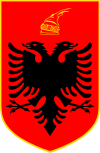Islam in Albania

| Islam by country |
|---|
 |
|
|
| Part of a series on |
| Albanians |
|---|
 |
|
|
During the Ottoman rule, according to Ottoman data, the majority of Albanians were of Muslim affiliation (Sunni and Bektashi Shiism). However, decades of state atheism which ended in 1991 brought a decline in religious practice in all traditions.

A recent Pew Research Center demographic study put the percentage of Muslims in Albania at 79.9%,[1].
History
Ottoman period
Islam came to Albania through the Ottoman rule in the 14th century and had to confront with Christianity. In the North, the spread of Islam was slower due to Roman Catholic Church's resistance and the mountainous terrain which contributed to curb Muslim influence. In the center and south, however, by the end of the seventeenth century the urban centers had largely adopted the religion of the growing Albanian Muslim elite. The existence of an Albanian Muslim class of pashas and beys who played an increasingly important role in Ottoman political and economic life became an attractive option career for most Albanians.
The Muslims of Albania during were divided into two main communities: those associated with Sunni Islam and those associated with the Bektashi Shiism, a mystic Dervish order that came to Albania during the Ottoman period, primarily during the 18th and 19th centuries. The Bektashi sect is considered heretical by most mainstream Muslims. Historically Sunni Islam found its strongest base in northern and central Albania, while Bektashis were found primarily in the Tosk lands of the south.
Independence

The country won its independence from the Ottoman Empire in 1912. Following the National Renaissance tenets and the general lack of religious convictions [2], during the 20th century, the democratic, monarchic and later the totalitarian regimes followed a systematic dereligionization of the nation and the national culture. Due to this policy, as all other faiths in the country, Islam underwent radical changes.
In 1923, following the government program, the Albanian Muslim congress convened at Tirana decided to break with the Caliphate, established a new form of prayer (standing, instead of the traditional salah ritual), banished polygamy and the mandatory use of veil (hijab) by women in public, practices forced on the urban population by the Ottomans.[3]
The Muslim clergy, following suit with the Catholic and Orthodox clergy, was totally eradicated during the communist regime of Enver Hoxha who declared Albania the only non-religious country of the world banning all forms of religious practice in the public in 1967.
Today Albania is the only entirely European member of the Organisation of the Islamic Conference.[4]
See also
References
| This image is available from the United States Library of Congress Prints and Photographs Division under the digital ID {{{id}}} This tag does not indicate the copyright status of the attached work. A normal copyright tag is still required. See Wikipedia:Copyrights for more information. |
- ^ Miller, Tracy, ed. (2009), Mapping the Global Muslim Population: A Report on the Size and Distribution of the World’s Muslim Population (PDF), Pew Research Center, retrieved 2009-10-08
{{citation}}: Unknown parameter|month=ignored (help) - ^ John Hutchinson, Anthony D. Smith, "Nationalism: Critical Concepts in Political Science"
- ^ Albania dispatch, Time magazine, April 14, 1923
- ^ Official website of the OIC
